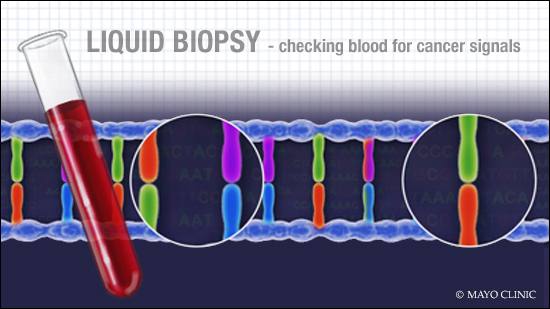-
Mayo Clinic Q and A: What is a liquid biopsy?
 DEAR MAYO CLINIC: What is a liquid biopsy? Can it be used in place of a tumor biopsy to find cancer?
DEAR MAYO CLINIC: What is a liquid biopsy? Can it be used in place of a tumor biopsy to find cancer?
ANSWER: A liquid biopsy involves examining cancer-related material (like DNA) from a blood sample. At this time, a liquid biopsy can’t replace a tumor biopsy. But researchers are studying the benefits of, and best uses for, liquid biopsies. They show promise in guiding individualized approaches to cancer management. Eventually, liquid biopsies also may be able to help health care providers screen for some forms of cancer.
Cancer is characterized by cell changes, including mutations and other genetic alterations, which lead to the development of abnormal cells that divide uncontrollably. Identifying the specific alterations associated with a person’s cancer can help health care providers determine the best treatment for that individual.
The diagnosis and characterization of cancers require tissue sampling through a tumor biopsy. This involves taking a sample of the cancerous tissue or cells through an invasive procedure and examining the sample in a lab. Tumor biopsies offer a wealth of information for health care providers to use when developing a cancer treatment plan.
But biopsies have limitations. First, a tumor changes over time as it grows, spreads (metastasizes) and is exposed to anti-cancer medications. That means tumor biopsies taken when the disease is first diagnosed may not reflect the current state of the cancer. Second, repeating biopsies to get updated information about cancer is invasive and associated with potential complications, including pain, infection and bleeding. Third, cancer cells that spread to different areas of the body may differ somewhat from the cancer at the site where it started. As a result, a tumor biopsy from one part of the body is unlikely to adequately represent cancer throughout the body.
Going through multiple biopsy procedures is not practical and can be difficult on patients. Liquid biopsies may offer an alternative for monitoring cancer over time that is less expensive and less invasive, and thus easier to repeat, than tumor biopsies. In addition, genetic material from all sites of disease is released into the circulation, so blood sampling may provide a real-time, representative view of the evolving cancer throughout the body.
Information gained from liquid biopsies should help health care providers select the best therapy for a patient at a given time in the course of metastatic disease. Blood-based monitoring also may indicate the need to switch to a different treatment regimen before changes appear on an imaging exam. In the setting of early-stage cancer, periodically checking the blood for cancer signals after potentially curative therapy could identify patients who are at risk for recurrence. Some research suggests that liquid biopsies may be able to detect when cancer returns long before a tumor reappears. That could lead to earlier intervention and improved survival.
With continued research and technological improvements, the liquid biopsy ultimately may become a tool for cancer screening. Early detection is expected to improve cancer-related outcomes. This is particularly important for those cancers currently without effective methods of screening and prevention.
Although liquid biopsies still are being researched, the potential they offer to provide a new way to monitor the presence of cancer, track cancer’s response to treatment and watch for a recurrence of cancer using a blood test could be a significant step forward in cancer care. — Dr. Minetta C. Liu, Medical Oncology, Mayo Clinic, Rochester, Minnesota







